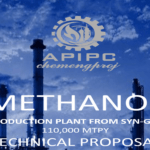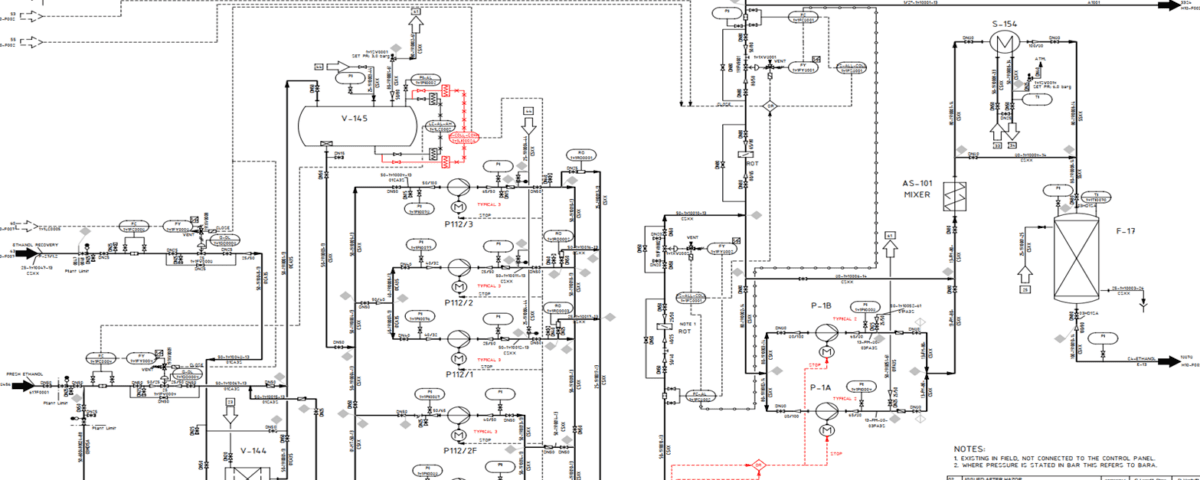Introduction
Introduction to MTBE and Its Importance in the Oil and Petrochemical Industry
Methyl Tertiary Butyl Ether (MTBE) is an organic compound from the ether group used as an oxygenate additive in gasoline. The primary goal of MTBE production in the oil industry is to improve fuel octane ratings and reduce environmental pollutants such as carbon monoxide (CO) and unburned hydrocarbons. Due to its favorable physical and chemical properties, this substance has been considered a replacement for tetraethyl lead (TEL) in many countries.

MTBE also improves combustion quality in internal combustion engines due to its high solubility in fuel and uniform blending with gasoline, providing optimal performance in combustion systems.
Applications of MTBE
MTBE (Methyl Tertiary Butyl Ether) is a versatile chemical with widespread applications across various industries. As a fuel derivative, MTBE plays a key role in enhancing the octane rating of high RON gasoline, which is essential for modern engines. In the chemical sector, its derivatives, such as pure isobutylene, are widely used in advanced production processes, including electronic displays (e.g., flat-screen TVs and mobile phone screens) and synthetic rubber in the automotive industry. Additionally, MTBE serves as a solvent in the production of fragrances and flavorings for pharmaceuticals, cosmetics, oral care products, mimicking profiles like lemon and mint. It also holds significant importance in paint thinners for industrial and consumer markets.
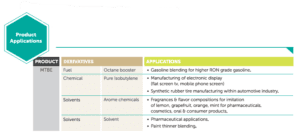
Specifications of MTBE
The specifications of MTBE reflect its high quality and compliance with international standards. With a minimum purity of 98% and strict control over impurities such as methanol (maximum 0.5%) and C4s (maximum 0.5%), the product ensures high performance and reliability. Critical parameters such as water content (maximum 500 ppm) and total sulfur (maximum 10 ppm) are closely monitored to align with environmental and operational standards. The density of the product at 25°C is 0.74 g/cm³, meeting industrial benchmarks. These specifications, validated through methods like ASTM D5441-98 and ASTM E1064-85, demonstrate the superior quality of MTBE for demanding fuel and chemical applications.

MTBE Production Processes and Reverse Engineering
MTBE is produced through the reaction of isobutylene and methanol in the presence of an acidic catalyst. There are two main processes for producing this compound:
- Traditional Reactor Process : This involves a fixed-bed reactor where the reaction occurs under controlled temperature and pressure conditions, followed by purification via separation and distillation steps.
- Reactive Distillation Process : This newer method combines the reaction and separation processes in a single unit, increasing efficiency, reducing energy costs, and improving conversion rates.
Reverse engineering of Honeywell technology was conducted in this project to thoroughly analyze production processes, design key equipment, and optimize operational parameters. This approach enables the localization of technology and optimization of energy and raw material consumption.
Project Objectives
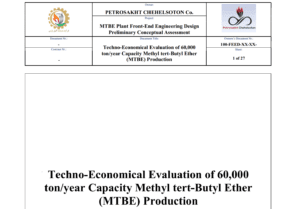
This report presents the results of the technical and reverse engineering assessment project for MTBE production with an annual capacity of 60,000 tons, conducted for PetroSakht Chehelsoton . The scope of activities includes:
- Evaluating existing production processes and technologies to determine the most suitable method for operational conditions.
- Modeling and simulating the process in Aspen Plus software for detailed analysis and optimization.
- Conducting a technical and economic analysis of different MTBE production processes, reviewing the advantages and disadvantages of each method.
- Assessing operational challenges and proposing optimization solutions to increase efficiency and reduce costs.
- Developing technical knowledge for the localization of Honeywell technology and assessing its feasibility for implementation under Iranian industrial conditions.
Economic and Environmental Importance of the Project
Given the growing global demand for MTBE and the need to comply with stringent environmental standards, developing advanced technologies for efficient and cost-effective production of this compound is a strategic necessity. The completed project at PetroSakht Chehelsoton , through optimizing energy consumption, reducing operational costs, and minimizing environmental impacts of MTBE production, has provided a practical model for developing downstream petrochemical industries in the country. The results indicate that using advanced technologies and sophisticated control systems can enhance production efficiency and reduce overall costs, significantly improving the competitiveness of petrochemical units in the global market.
MTBE Production Technologies
Chemical Reaction and Production Principles
MTBE production is based on the reaction between isobutylene (i-C4H8) and methanol (CH3OH) in the presence of an acidic catalyst such as ion-exchange resins. The main reaction is as follows: This reaction occurs at temperatures between 40–100°C and pressures of 1–10 bar. Due to its equilibrium nature, selecting appropriate operating conditions is crucial for maximizing isobutylene conversion.
Methods of MTBE Production
There are two primary methods for industrial-scale MTBE production, each with unique characteristics, advantages, and challenges:
- Conventional Process (Fixed-Bed Reactor + Distillation) : This method uses fixed-bed reactors and separate distillation systems. The reaction initially takes place in a reactor, followed by MTBE separation via distillation columns.
- Reactive Distillation Process (RD) : In this method, the reactor and distillation column are combined into a single unit, allowing simultaneous reaction and separation. The main advantage of this method is improved production efficiency and reduced operational costs.
PetroSakht Chehelsoton Company
PetroSakht Chehelsoton is one of the leading companies in Iran’s petrochemical and refinery industries, focusing on designing, developing, and implementing engineering and production projects for hydrocarbon products. The company plays a vital role in meeting the country’s oil and gas industry needs by leveraging specialized engineering teams, advanced technologies, and collaborations with reputable domestic and international companies.
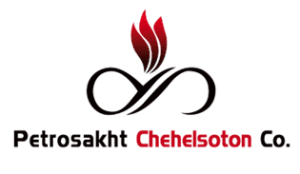
Its areas of activity include:
- Design and implementation of process units in the petrochemical industry.
- Reverse engineering of industrial equipment and processes.
- Providing energy optimization solutions for refinery units.
- Managing EPC projects in the oil and gas industries.
- Specialized consulting for the development and optimization of chemical processes.
With extensive operational experience and access to international scientific and technical resources, PetroSakht Chehelsoton has established itself as a credible player in Iran’s petrochemical industry. The company is committed to adopting international standards, developing indigenous technologies, and increasing efficiency in process industries.
Selection of Optimal Technology for the Project
Based on technical and economic analyses, the reactive distillation process (RD) is recommended as the optimal choice for the MTBE production project at PetroSakht Chehelsoton . Key reasons for this selection include:
- Higher process efficiency and reduced raw material waste.
- Lower operational and capital costs through reduced equipment requirements.
- Greater compatibility with environmental and international standards.
The findings of this study will serve as the foundation for designing and implementing optimal technology in the MTBE production unit, with further details covered in subsequent sections of the project.
Reverse Engineering of Honeywell Technology
Necessity of Reverse Engineering in MTBE Production
Reverse engineering of industrial processes is a key solution for localizing advanced technologies and optimizing production processes. In this project, reverse engineering of Honeywell technology was conducted to analyze and improve the MTBE production process. This technology is one of the most advanced MTBE production methods globally, offering high efficiency and reduced operational costs.
Stages of Reverse Engineering
The reverse engineering of Honeywell technology in this project included the following key stages:
Equipment Review
The key equipment used in the MTBE production unit at PetroSakht Chehelsoton , including reactors, reactive distillation columns, heat exchangers, and methanol recovery systems, was reviewed and analyzed. The aim was to evaluate equipment efficiency and identify opportunities for energy consumption optimization and process yield improvement.
Operational Condition Analysis
Operational conditions directly impact reaction yield and energy consumption. The key parameters analyzed included:
-
- Operating temperature of the reactor and reactive distillation column.
- System pressure and its effect on azeotropic formation.
- Molar feed ratio of methanol to isobutylene.
- Residence time of materials in different process units.
Analysis results showed that precise adjustment of these parameters could increase isobutylene conversion efficiency up to 99%.
Process Modeling and Simulation in Aspen Plus
Aspen Plus software was used as an advanced tool for modeling and simulating chemical processes. In this project, modeling included:
- Accurate definition of chemical reactions and selection of appropriate kinetic models.
- Modeling of mass and energy transfer in the reactive distillation column.
- Simulation of operational parameter changes and analysis of their effects on unit performance.
Simulation results demonstrated that optimizing the internal design of the reactive distillation column could reduce energy consumption by up to 15% and increase MTBE purity.
Importance of Localizing Honeywell Technology in MTBE Production
One of the primary goals of this project was to localize Honeywell technology for MTBE production. This technology, as one of the most advanced MTBE production methods, offers numerous benefits in reducing energy consumption, increasing reaction efficiency, and optimizing equipment performance. Through reverse engineering and technical knowledge development in this project, it became possible to design and implement high-efficiency production processes with optimized operational costs. Furthermore, optimizing operational conditions and controlling key parameters as part of the reverse engineering process contributed to increased production yield and reduced process costs. Localizing this technology reduced dependency on foreign suppliers and developed domestic infrastructure for MTBE production in compliance with global standards.
System Behavior Analysis Under Different Operating Conditions
To evaluate the performance of the MTBE production unit under various operating conditions, multiple operating scenarios were simulated in the software:
- Nominal operating capacity (60,000 tons per year).
- Reduced operating capacity by 10% to assess feed fluctuations.
- Non-ideal operating conditions, such as changes in feed composition and increased reaction temperature.
Analysis of these scenarios showed that the MTBE production unit based on Honeywell technology had high flexibility against operational variations and could maintain optimal performance through precise control of temperature and pressure.
Technology Comparison
Key Criteria for Selecting MTBE Production Technology
Selecting the optimal technology for MTBE production requires thorough evaluation of the following key criteria:
- Isobutylene Conversion Efficiency : The amount of isobutylene converted to MTBE directly affects productivity and product quality. Higher efficiency means reduced waste, increased profitability, and optimized raw material usage.
- Energy Consumption and Operational Costs : Different MTBE production processes consume varying amounts of energy. Reducing energy consumption lowers operational costs and improves economic efficiency. Selecting a process with minimal energy consumption is critical from both economic and environmental perspectives.
- Process Complexity and Equipment Requirements : Some technologies require advanced and complex equipment, potentially increasing initial investment costs. Simpler technologies may have higher operational costs. Balancing process complexity with operational capabilities is an important step in selecting suitable technology.
- Compatibility with Existing Industrial Infrastructure : The selected technology must align with the country’s industrial infrastructure, operational capacities, and environmental and safety standards to ensure feasible and economical implementation.
Review and Comparison of Different MTBE Production Technologies
Conventional Reactor Process (Fixed-Bed Reactor + Distillation)
In this method, isobutylene and methanol react in a fixed-bed reactor, and the product is purified via distillation columns. This method has been widely used in older petrochemical units.
- Advantages :
- Simple structure and easy process control.
- Standard equipment available in many petrochemical units.
- Disadvantages :
- High energy consumption in separation stages.
- Higher operational costs due to the need for multiple separation units.
- Lower efficiency compared to advanced methods.
Reactive Distillation Process (RD)
This technology simultaneously performs reaction and separation in a single distillation column, improving efficiency and reducing energy consumption. It has replaced conventional methods in many advanced petrochemical complexes.
- Advantages :
- Increased isobutylene conversion efficiency up to 99.2%.
- Reduced energy consumption using heat generated during the reaction.
- Fewer required equipment, resulting in reduced capital costs.
- Disadvantages :
- Complex design requiring precise process control.
- Need for accurate modeling for optimal performance.
Quantitative Comparison of MTBE Production Technologies
The table below provides a comparison of the key features of the two main MTBE production technologies.

Selection of Optimal Technology
Based on the evaluations, the reactive distillation process (RD) is the optimal choice for the 60,000-ton-per-year MTBE production unit at PetroSakht Chehelsoton due to its higher efficiency and reduced operational costs. This technology not only enhances production performance but also reduces energy consumption and environmental impacts.
Basic Engineering Studies (FEED)
Following the selection of the reactive distillation process (RD) as the optimal method for MTBE production in this project, the next step involved conducting basic engineering studies (Basic Engineering) and detailed engineering (FEED) for precise design and process optimization.
These studies included:
- Detailed process design analysis and determination of optimal operational parameters to achieve maximum efficiency and reduced energy consumption.
- Process modeling and simulation in Aspen Plus software to evaluate the impact of various operational conditions on unit performance.
- Equipment selection and design of advanced control systems to ensure stable production and precise chemical reaction control.
- Economic evaluation and cost optimization of capital and operational expenses to enhance productivity and reduce production costs.
These studies formed the foundation for the successful design and execution of this project, ensuring that MTBE production at PetroSakht Chehelsoton adheres to international engineering standards with the highest level of efficiency.
Technical and Economic Challenges
Control of Feedstock Quality and Isobutylene Composition
One of the key challenges in MTBE production is the quality and composition of the incoming feedstock. Isobutylene, as the primary raw material, must have high purity because impurities such as normal-butylene and other hydrocarbons can negatively affect catalyst performance and reaction efficiency. Proposed Solutions:
- Use of advanced separation technologies such as high-purity distillation and surface absorption to improve feedstock quality.
- Continuous monitoring of feedstock composition and adjustment of operational parameters to maintain isobutylene purity.
Management of Energy Costs and Optimization of Consumption
Energy consumption in MTBE production units represents one of the largest operational costs. Cooling, heating, and distillation processes require significant energy, directly impacting production costs. Proposed Solutions:
- Recycling energy from exhaust streams to reduce energy consumption and enhance efficiency.
- Optimizing operational conditions through temperature and pressure adjustments to minimize fuel consumption.
- Use of high-efficiency thermal technologies such as high-performance heat exchangers to reduce energy costs.
Selection and Replacement of Suitable Catalysts
Catalysts used in MTBE production must possess high thermal stability and activity to maintain reaction efficiency over extended periods. However, catalyst deactivation over time leads to reduced conversion rates and increased replacement costs. Proposed Solutions:
- Development and use of new catalysts with longer lifespans and resistance to deactivation.
- Regeneration of used catalysts instead of complete replacement to reduce operational costs.
- Monitoring catalyst performance and implementing preventive maintenance programs.
Environmental Constraints and Compliance with International Standards
MTBE production must comply with strict international environmental regulations since some by-products of this process may have adverse environmental effects. Proposed Solutions:
- Use of advanced wastewater treatment systems to reduce pollutants and prevent environmental contamination.
- Compliance with international environmental standards and implementation of emission monitoring systems.
- Development of new technologies to minimize unwanted by-product generation and enhance environmental efficiency.
Technical and economic challenges in MTBE production primarily relate to feedstock quality, energy consumption, catalyst performance, and environmental requirements. By implementing energy optimization strategies, advancing separation and purification technologies, and utilizing advanced catalysts, production efficiency can be enhanced, and operational costs can be reduced. Consequently, MTBE production can be implemented as a sustainable and economically viable industrial process.
Conclusion
Studies conducted in this project demonstrate that the reactive distillation process (Reactive Distillation – RD) is recognized as the optimal option for MTBE production with a capacity of 60,000 tons per year. Key advantages of this technology include:
- Increased production efficiency: The RD process can increase isobutylene conversion efficiency up to 99.2%, significantly higher than traditional methods.
- Reduced capital and operational costs: Integrating reaction and separation into a single unit reduces the need for separate equipment, decreases energy consumption, and lowers overall project costs.
- Greater alignment with environmental standards: This technology reduces by-product generation and consumes less energy, minimizing environmental impacts and aligning better with international standards.
Related Projects
Technical Knowledge and Simulation of MIPA Process (Aspen Plus)
Technical Knowledge of Aromatics to Petrosakht-Chehelsoton Co.
Summary
APIPCO, leveraging extensive technical knowledge and experience in chemical engineering and the petrochemical industry, successfully executed the design and technical evaluation project for MTBE production with a capacity of 60,000 tons per year for PetroSakht Chehelsoton . All stages of basic engineering (Basic Engineering), detailed engineering studies (FEED), and reverse engineering of Honeywell technology were meticulously performed with a scientific approach.
Through advanced modeling and simulation in Aspen Plus, technical and economic analysis of production processes, and optimization of operational conditions, APIPCO provided a comprehensive and effective solution for MTBE production with maximum efficiency and minimal operational costs. This project not only facilitated the localization of advanced international technologies but also optimized energy consumption and reduced environmental pollutants, adhering to global standards for high-quality fuel production.
The success of this project demonstrates APIPCO‘s capability in providing advanced engineering services and developing optimal technologies in the petrochemical industry. The company is prepared to share its expertise and technical knowledge with other active companies in this field and act as a strategic partner in developing similar projects at national and international levels. If your company seeks to design and optimize MTBE production units, develop technical knowledge, or implement reverse engineering projects, APIPCO is ready to collaborate and offer innovative and specialized solutions with the highest international standards.
